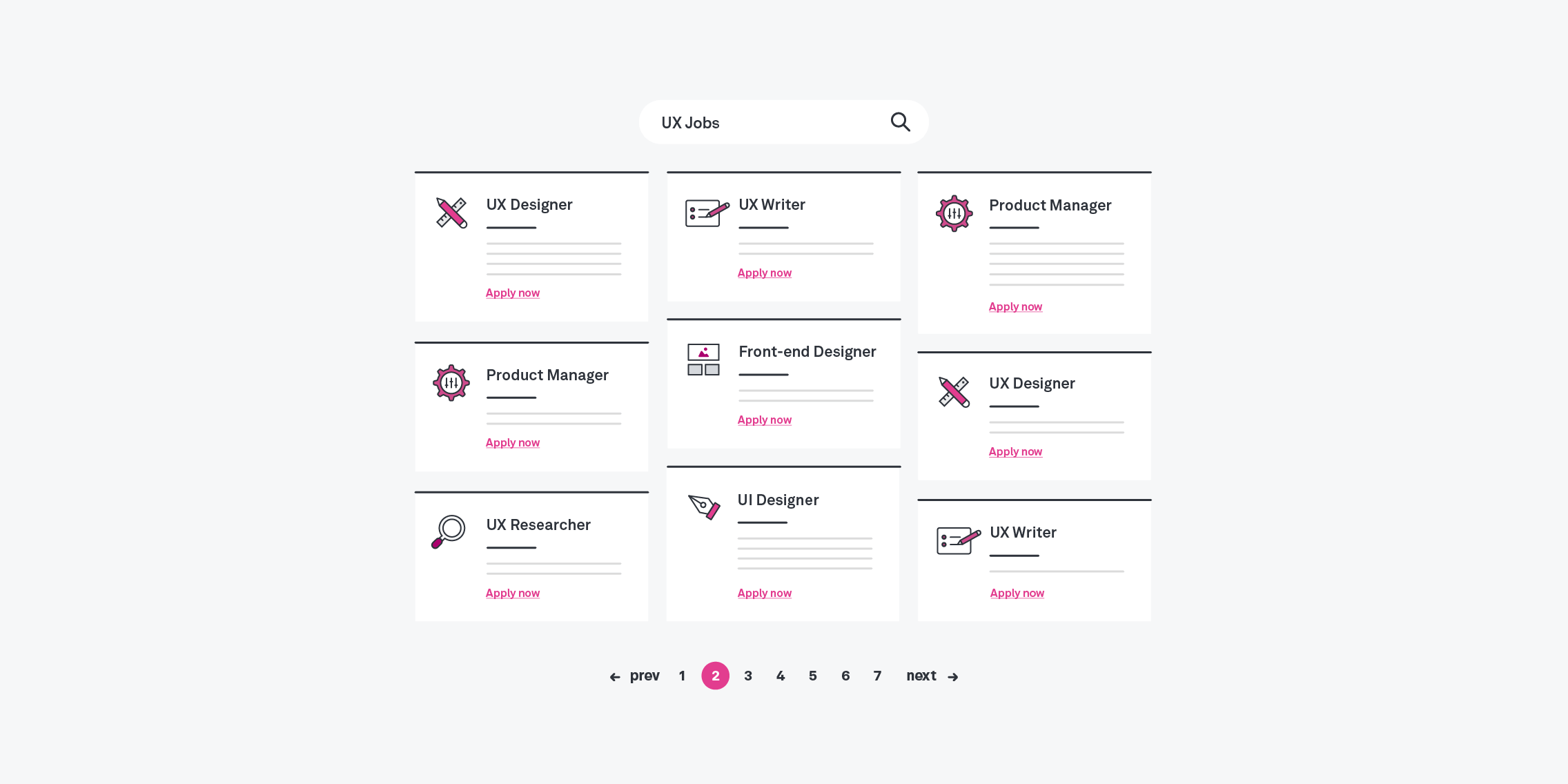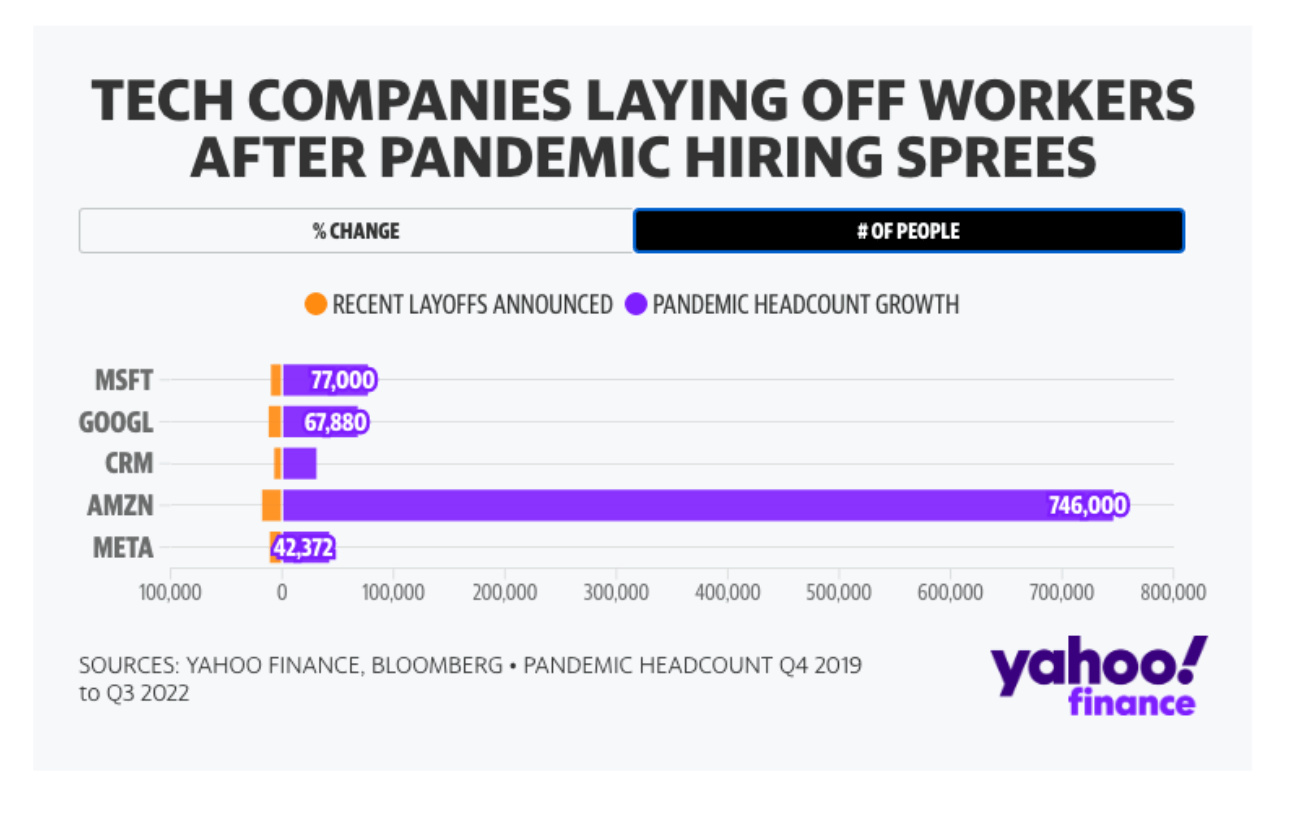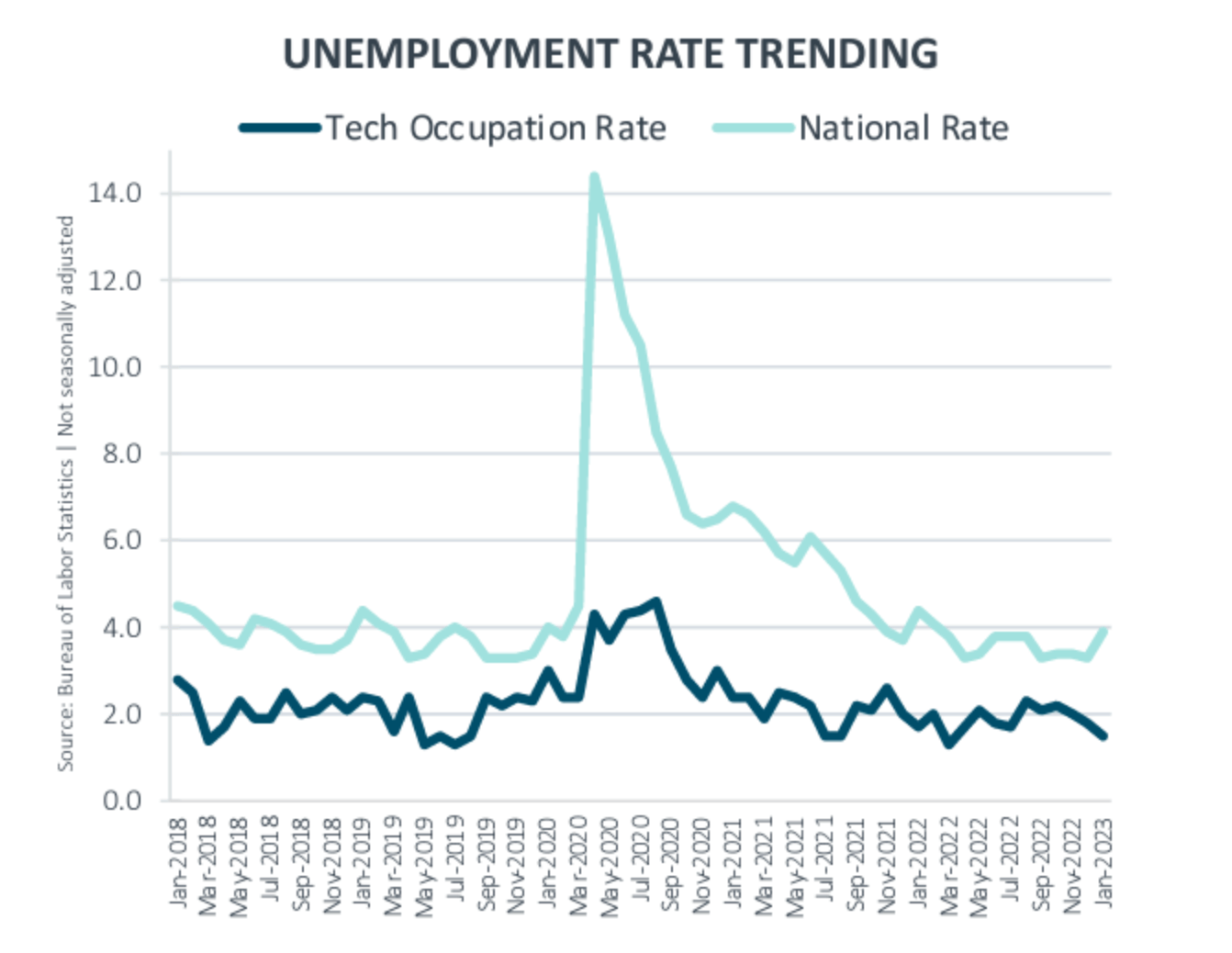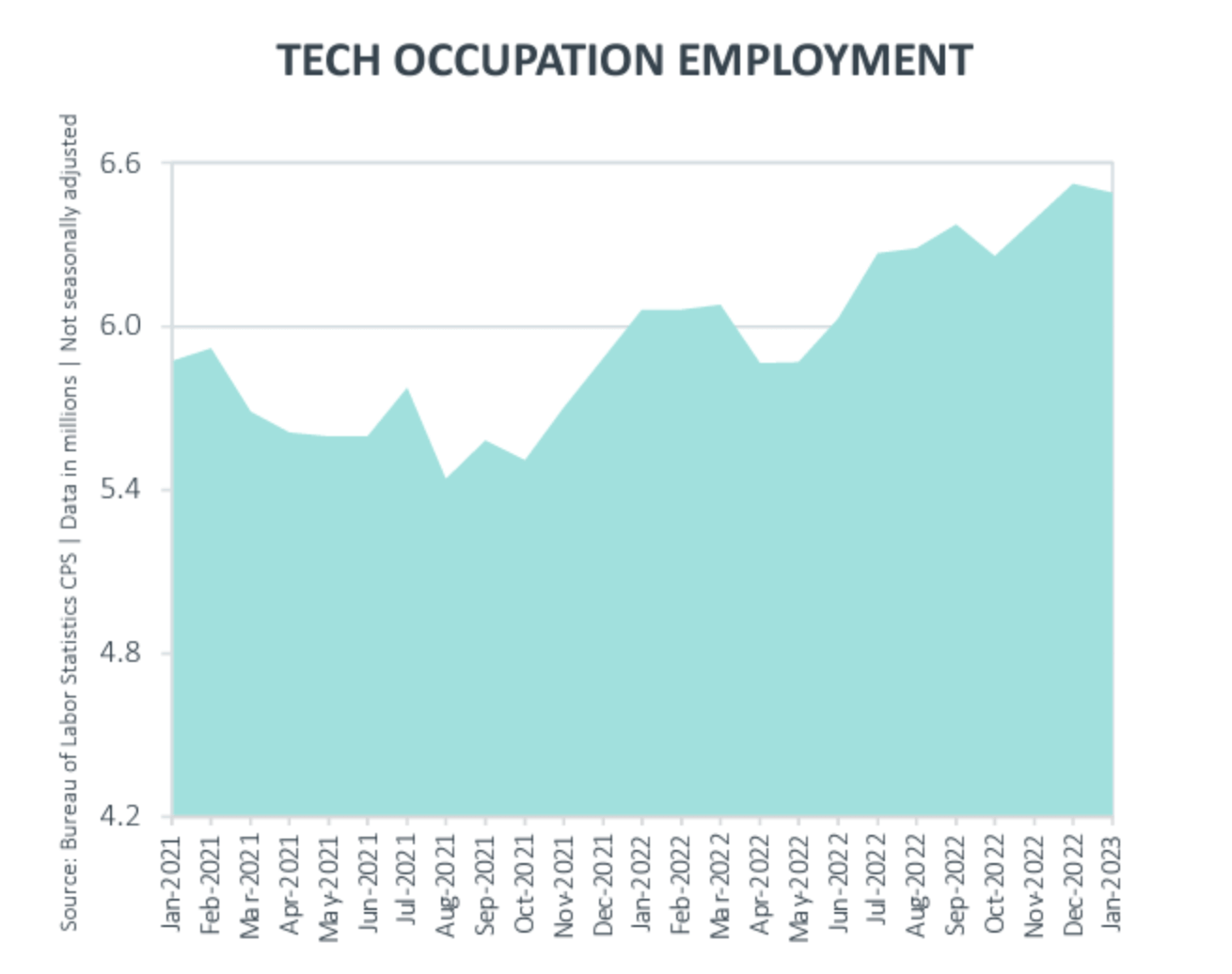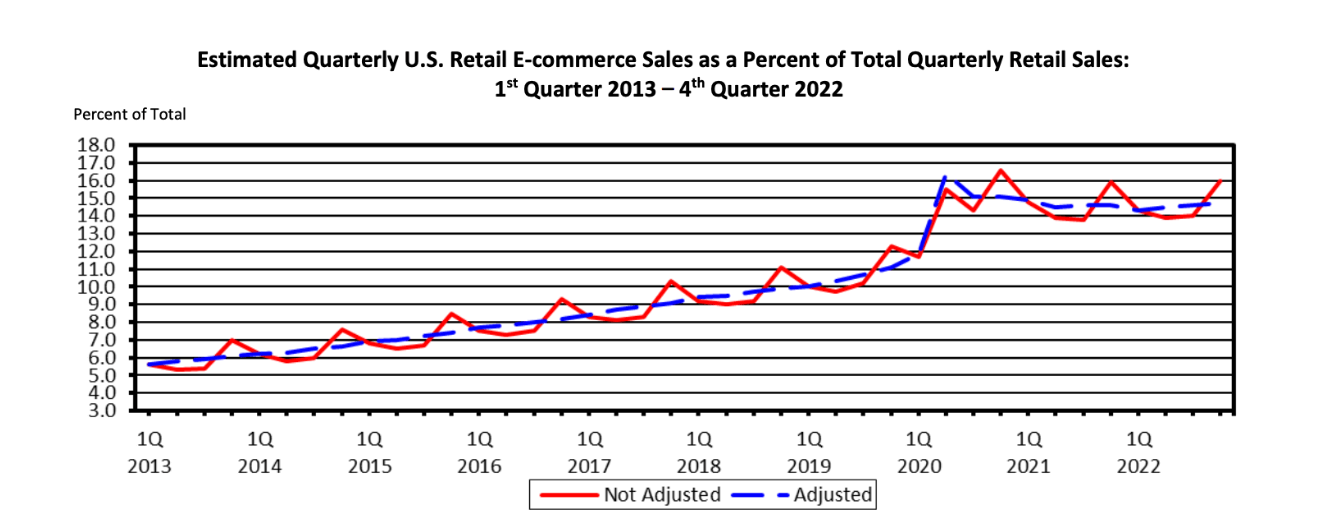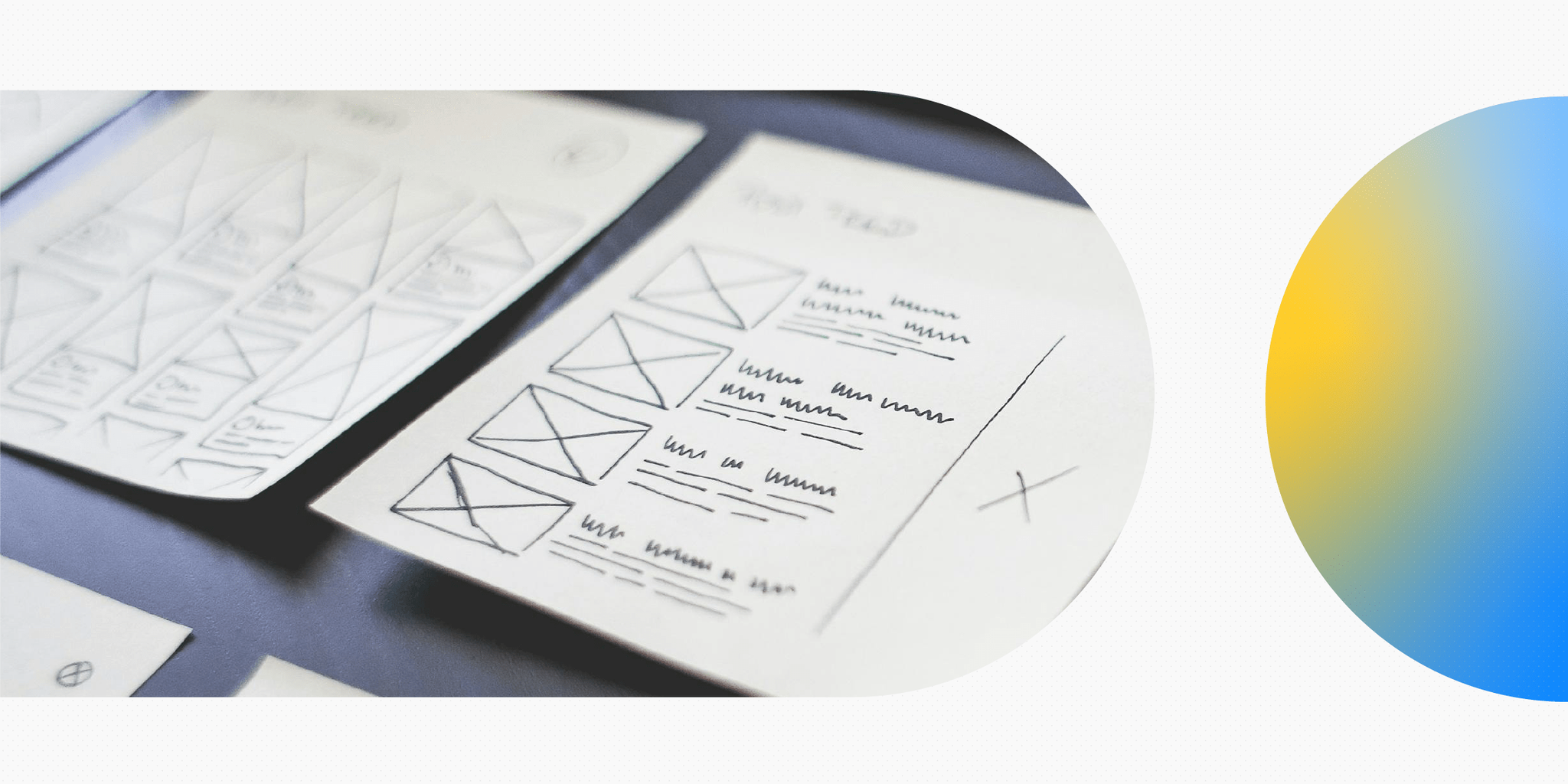Is now the right time to start a career in UX?
If you only read the news headlines, you might not think so.
Every day brings news of another tech giant laying off thousands of workers. US-based tech companies cut 140,000 jobs in 2022. They cut another 94,000 workers by March 2023.
Fortunately, when you dig into the data beyond the headlines, you’ll find tech and UX job opportunities are as plentiful as they’ve ever been.
To give you a more accurate picture of the current UX job market, we researched open UX roles and spoke to hiring managers to uncover:
- Why the big tech layoffs are misleading
- Who’s still hiring in tech and UX
- Why UX roles are still in big demand
- Tips for landing a role in the current UX job market
Let’s jump right in with the real story behind the layoffs.
The big tech layoffs are overblown
According to Goldman Sachs research, most big tech layoffs are coming from tech companies with three things in common:
- They hired aggressively during the pandemic. On average, the companies undergoing mass layoffs recently saw their headcounts grow by 41% between Q4 2019 and Q3 2022.
- They benefited from temporary pandemic-related trends such as increased demand for goods or time spent online.
- They have seen sharper declines in their stock prices—an average of 43% lower than their peaks on average.
This graph from Yahoo Finance illustrates how small the recent layoffs are in contrast to the tech giants’ pandemic headcount growth:
In reality, the tech unemployment rate is hitting record lows.
A January job report from the U.S. Bureau of Labor Statistics (BLS) found the unemployment rate in the tech job market was only 1.5%—even lower than the December rate of 1.8%.
This graph from an early 2023 CompTIA Tech Jobs Report shows that tech’s unemployment rate in the U.S. has been on a consistent decline since the peak of the pandemic.
The same report shows the total number of tech roles is near its highest levels since 2021.
In fact, it’s been a struggle to fill those roles. In January 2023, there were over 109,000 unfilled tech jobs due to a lack of qualified candidates (according to the same CompTIA report).
But if there are so many layoffs happening in big tech, how has the tech job market stayed consistently strong?
Where are all the tech jobs coming from?
Tech jobs have stayed consistent because there are many tech employers beyond the big Silicon Valley tech companies.
According to a recent New York Times article, “a majority of tech jobs are at companies outside the tech sector in industries like banking, retail, health care, and manufacturing whose operations are increasingly becoming digital.”
These traditional industries have upped their tech workforces after they were forced to modernize during the pandemic.
The New York Times cites Walmart as an example, which has hired over 20,000 engineers, data scientists, and product managers since the pandemic to build up its ecommerce and delivery services.
Who’s hiring in UX?
Tech jobs are clearly in demand, and hiring data suggests UX roles are some of the most in-demand tech jobs out there:
- Glassdoor listed UX Designer as the 24th best job to have in the US based on salary data, job satisfaction, and open roles. (Most of the top 20 were also tech jobs.)
- The U.S. Bureau of Labor Statistics projects Web Developer and Digital Designer roles (including UX roles) will rise by 23% between 2021 and 2023 (which it describes as “much higher than average”)
- 91% of recruiters are “extremely, very, or somewhat concerned that recruitment and hiring methods will not be enough to fill their open software engineering, data analytics, data science, and UX design positions in today’s labor market.”
At the time of writing this article in March 2023, a search for full-time UX designer jobs on Indeed, pulled up:
For UX researcher jobs, there are:
A broader search for any role with “UX” in the job title or description reveals:
This includes roles such as product manager, product designer, frontend designer, conversion rate optimization, and more.
Let’s take a closer look at which industries are hiring in UX.
Financial sector
We asked Eoghain Cooper, former Technical Sourcing Specialist at Google and current Alumni Career Advisor at the UX Design Institute about which industries are hiring in UX right now.
He immediately brought up the financial industry.
“There’s a bit of a panic within the financial and wealth management sector,” said Cooper. “There’s a big trend in banks going digital-first to insulate themselves from challenger banks like Revolut or transfer apps like CashApps.”
“Looking at Bank of America, for example, they’re hiring a lot more UX roles into their teams. A lot of what they do is more backend, but they might hire UX designers for dashboards for creators and analysts.”
Open job listings on Indeed confirm that trend, as there are currently double-digit open roles at:
- Accenture (US, Canada)
- Citi
- Deutsche Bank
- JP Morgan Chase
- NatWest
- PwC
- Santander
- TD Bank
- Wells Fargo
Manufacturing
Ronan Costello, Director of Digital Customer Experiences at Analog Devices, says that UX is a big focus in the manufacturing industry right now.
“Together with our customers, we are solving society’s toughest challenges (think: space tech, sustainable energy, electric vehicles, and digital healthcare),” said Ronan. “So it makes sense that we are doubling down on our customer focus.”
“The team has doubled in size over the last four months alone and will continue to scale up throughout the year.”
In addition to Analog Devices, other manufacturing companies like Eaton, Cox Enterprises, and Xylem all have UX job openings on Indeed.
Retail & Ecommerce
As of the end of 2022, 14.7% of total retail sales in the US come from ecommerce. This is up over 50% from pre-pandemic levels and nearly 300% from a decade ago.
This has pushed brick-and-mortar retailers to become tech companies. They are increasingly hiring in-house UXers to work on mobile shopping app design, website conversion rate optimization, and more.
Retailers like Lowes, Tesco, Ikea, and Walmart have lots of open UX roles, as do many ecommerce companies, such as Chewy.
Digital Marketing Agencies
According to Eoghain Cooper, the largest UX growth area he sees at the moment is in the digital marketing space:
“Agencies are scaling up their teams massively. They have team sizes of 30+ with no slow-downs in hiring. These are notable design firms like Critical Mass and Dentsu.”
“They are mostly hiring qualified junior talent and then training them up in-house with the goal of retaining staff long-term. They hire UX generalists who do a lot of design work and some research. It’s where we find most graduates are looking.”
We talked to Helen Willmot, Director of UX & Optimisation at Dentsu, who said there are lots of marketing-focused roles emerging for UXers.
“We’re more commercial than a lot of UX teams. We tend to focus on pre-purchase journeys. We care more about persuasion, behavioural design, emotional design—what makes people purchase.”
Other agencies with open roles on Indeed include Alludo and Hippo Digital.
Tech Companies
Of course, there are also many tech companies outside the big giants hiring for UX.
Braintrust, VMware, Autodesk, Jerry, and many others have double-digit UX positions open.
Why UX professionals are still in high demand
The next question to ask is whether the demand for UX will keep up if we go into a recession. Is there anything about UX that makes it more future-proofed?
Here are some reasons why the demand for UX is likely here to stay.
More demand for tech means more demand for UX
In a recent Forbes article about in-demand tech skills, renowned futurist Bernard Marr explained how the continuing reliance on technology will lead to more UX roles:
“This democratization of technology really just means that everyone, no matter what their role is, is expected to work with technology to some extent. And that means that technology has to be usable by anyone, even those without the skills traditionally needed to work with technology, such as software and programming skills.”
“As consumers continue to value experience above other aspects of products and services they purchase (such as value-for-money or quality), then the skillset of the UX designer will become increasingly in demand.”
Ronan Costello of Analog Devices echoed this point too: “Think about all the companies looking to harness ChatGPT in their products. So many only fall into the realm of cool toys.”
“But then you’ve got a handful of companies like Intercom delivering ChatGPT features that solve REAL problems in less than 8 weeks since ChatGPT itself was launched. The future is bright.”
Companies see UX as risk avoidance, not a luxury
While UX used to be seen as a nice-to-have luxury expense, it’s now seen as a way to avoid risk.
“In times of economic uncertainty there is understandably less room for guesswork and gambles,” said Ronan Costello.
“Uncertainty in itself can’t be eliminated, but it can certainly be managed. UX design and research is critical to doing just that. Harnessing research with customers (interviews, usability tests, A/B testing) and using those insights in the design process for launch and in live optimisations mean our bets are less risky. We are not running blind.”
Eoghain Cooper explains that companies see an investment in UX as a logical business consideration, “Decent research at beginning of a project or throughout reduces development cost and time.”
Helen Wilmott said she’s seen a big shift in the way Dentsu’s clients value UX, too.
“If UX is valued the right way, it’s unlikely to be cut. There are certainly clients of ours who have embraced UX, they get the importance of it, and it would take a lot for them to cut back on it. They don’t view it as a luxury,” said Wilmott.
The UX industry is far from its maturity
In an essay on the next 100 years of UX, Jakob Nielsen, UX pioneer and founder of the NN Group, expects UX roles to keep growing because of three separate growth trends:
- UX maturity is growing within companies
- More companies are practicing UX
- More countries are practicing UX — it’s becoming a more global practice
Nielsen ambitiously predicts 1% of the world population will be in UX roles by 2050.
10 tips for the current UX hiring market
What else should UXers know about the current hiring market? Here are some helpful tips that came up in our conversations for helping you land and keep a role in UX.
- It’s a good time for junior UX roles. “A lot of the senior designers are the ones struggling [after big tech layoffs]. Their level of salary is difficult for smaller companies to match. From my own perspective on the market, there’s a stronger investment in junior talents that can be nurtured,” said Eoghain Cooper.
- It’s a good time to be a generalist. “There can be a temptation to specialize early. But a lot of jobs that were let go from tech were niche jobs (e.g., Design Ethicists). You’ll start to see more of a value on people who can be quite flexible and flip between different roles. If you are looking to become a UX designer, it can be worth keeping it broader,” said Helen Willmot.
- Tailor your CV. “New graduates and junior UXers are still making a lot of basic errors with CVs/resumes and portfolios. For example, a portfolio that shows one image, one sentence, and no indication of thought process or approach doesn’t help me much if I’m looking at 20-30 potential candidates. Think about how your portfolio maps to the role you are applying for. What is the hiring manager likely to be looking for,” said Ronan Costello.
- Don’t rush into the first role you’re offered. “Newer UX designers should choose their next career move wisely. Ask LOTS of questions about the team you will be joining, their place in the organisation, their progression paths, how success is measured, and most importantly, how you will learn from your peers,” said Costello.
- UX researchers are in big demand. “Great UX researchers are scarce right now. If you’re looking for an area of your UX toolkit to enhance, this is a good shout,” said Costello.
- UX writing is growing too. “UX writing is also a growing industry. They’ve been hit by layoffs in tech, but you’ll start to see increased demand in other industries,” said Willmot.
- Budget cuts normally impact research budgets first. “It’s more about budgets getting cut [than layoffs]. UX teams are being asked to do more with less. For example, on the research side of things, if you’ve been investing a lot in recruiting users, we might see that stripped back,” said Willmot.
- Learn to advocate for the commercial value of UX. “With higher commercial pressures, it’s worth learning how to advocate for your role and the commercial value of the UX function within a business. It can be hard to map revenue to UX, but the stats are there when you look at how fast companies who invest in this stuff grow. UXers need to be confident at pushing that narrative forward,” said Willmot.
- UXers are valued in other roles, too. “We tend to hire a lot of UXers [at Dentsu] into our strategy roles. For example, project management roles. They’re looking after conversion rate optimization for marketing and UX projects,” said Willmot.
- Diverse career experience is valued. “Lots of candidates having success transitioning into the UX space backed by courses like the UX Design Institute provides. Individuals with a blend of UX and non-UX experience can really create a fascinating addition to a team. Own that diverse experience!” said Costello.
Conclusion
If you were worried that you were late to the UX party—don’t be. It’s still a great time for a career in UX design.

